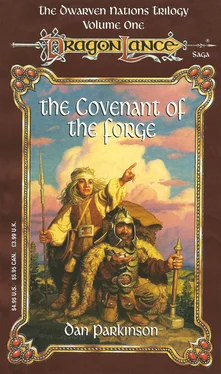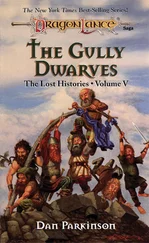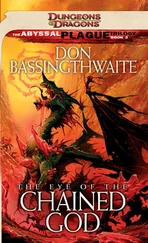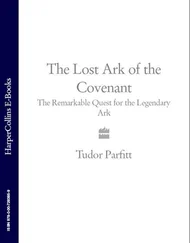Dan Parkinson - The Covenant of The Forge
Здесь есть возможность читать онлайн «Dan Parkinson - The Covenant of The Forge» весь текст электронной книги совершенно бесплатно (целиком полную версию без сокращений). В некоторых случаях можно слушать аудио, скачать через торрент в формате fb2 и присутствует краткое содержание. Жанр: Фэнтези, на английском языке. Описание произведения, (предисловие) а так же отзывы посетителей доступны на портале библиотеки ЛибКат.
- Название:The Covenant of The Forge
- Автор:
- Жанр:
- Год:неизвестен
- ISBN:нет данных
- Рейтинг книги:5 / 5. Голосов: 1
-
Избранное:Добавить в избранное
- Отзывы:
-
Ваша оценка:
- 100
- 1
- 2
- 3
- 4
- 5
The Covenant of The Forge: краткое содержание, описание и аннотация
Предлагаем к чтению аннотацию, описание, краткое содержание или предисловие (зависит от того, что написал сам автор книги «The Covenant of The Forge»). Если вы не нашли необходимую информацию о книге — напишите в комментариях, мы постараемся отыскать её.
The Covenant of The Forge — читать онлайн бесплатно полную книгу (весь текст) целиком
Ниже представлен текст книги, разбитый по страницам. Система сохранения места последней прочитанной страницы, позволяет с удобством читать онлайн бесплатно книгу «The Covenant of The Forge», без необходимости каждый раз заново искать на чём Вы остановились. Поставьте закладку, и сможете в любой момент перейти на страницу, на которой закончили чтение.
Интервал:
Закладка:
Humans and others outside of Thorin often thought of the dwarves as being heavily armed, but that was only because most truly fine weaponry in the region came from Thorin. The best of blades, the finest arrowheads, the most valuable spearpoints and daggers, even the massive war machines that human realms coveted, all came from the foundries, forges, and shops of the dwarves of Thorin. They were a major part of the Calnar’s stock in trade, because there were always so many people so anxious to have them.
It was said, among humans and other races, that the best steel was Calnar steel. The fact was, in all the realms within sight of the Khalkists at least, Calnar steel was the only steel. People of many races could craft in bronze and tin, and some in iron, but in these lands only the dwarves made steel.
Even the plainest Calnar trade sword would bring fifty bushels of grain at Balladine, and a Calnar steel arrowhead was worth as much as a Calnar steel coin. Humans preferred the arrowheads to coins because they had an alternate use in a pinch.
Thus, the Calnar were weapon makers for a large part of the world as they knew it. Dwarven weaponry was everywhere — except in Thorin. Few dwarves owned so much as a short sword, or cared to. To the practical-minded dwarves, a thing that was neither useful nor decorative was hardly worth having.
So there were few weapons in Thorin — as those outside of Thorin knew weapons. But there were tools. It was the nature of the Calnar: tools were as natural to them as breathing. They cherished their tools, and used them constantly.
Thus, the old saying: If there are enemies, raise your hammer and see it in a mirror.
The only difference between a hammer for driving a chisel in stone or for clearing tunnels, and a war-hammer, was in how one looked at it. An axe was for felling timber, a maul for splitting rails or squaring stone, a sling for delivering small tools and materials from one subterranean level to another, and a javelin was for securing lift-lines in climbs. But a good axe could as easily cleave bone as wood, a maul could as readily smash a shield as drive a wedge. A sling could throw missiles as well as supplies, and a well-aimed javelin could be as deadly as any spear.
A helmet was to protect one’s head from falling stone in a delve. A shield was for clearing rubble and deflecting rock showers. Body armor — sometimes metal and sometimes leather — was for working in the foundries, where sparks could fly, and in the finishing shops where implements might be flung from grindstones and burnishing wheels. But these could have other uses as well.
Raise your hammer and see it in a mirror. Look to the left side of your tools. Be ready to stop work and fight . It was a thing that any dwarf understood. The difference between a tool and a weapon is in the mind of the user and in the circumstances of use.
Word had already spread to the crafters’ galleries by the time Handil the Drum arrived there, carrying the great, deep-throated vibrar with which he had begun the Call to Balladine. The mighty drum was his own invention — a steel-banded barrel of tapered and curved hardwood slats, capped at each head by tightly drawn buffalo-hide leather. Within were other “heads” of various materials, each pitched to capture and amplify the resonance of the membrane before it. Oval openings around the center of the barrel broadcast its thunder when either head was struck.
Played atop the Sentinels, Handil’s drum could be heard for miles and its echoes much farther. The Thunderer was not the biggest drum in Thorin, but it was by far the most powerful.
He carried it wrapped and muted now — as the drums always were when brought within the undermountain realm.
The sun-tunnel lighted concourse leading to the crafters’ galleries was crowded, as usual, with dwarves hurrying here and there on their various errands. Handil stepped aside to let a sled crew pass. Two great Calnar horses in harness hauled an eight-foot block of hewn granite from one of the new delves while a dozen sturdy Calnar armed with prybars and mallets worked the skids. When the crew was past, Handil went on, nodding to an acquaintance now and then. Sledges rang at a side tunnel where cart rails and tow-rings were being placed for a new cable-way leading up from the farming warrens. Across the concourse, hewers and reaves were at work, fitting massive timbers into newly cut stone to expand the weavers’ stalls.
The chieftain’s order to be ready for trouble had put worried frowns on many of the faces in the concourse but had not interrupted the rhythm of the place. As always, there were Calnar everywhere, doing all kinds of things, and like every public part of Thorin, the great way was a bustling, flowing turmoil of busy dwarves.
Handil slowed his pace as he neared the shops. Here the corridors were even more crowded than usual, and it seemed everyone was carrying various tools and items of armor. Lines had formed as people waited their turns to sharpen spikes, fit wrist straps onto hammers, repair buckles on chest-guards, or mount horns or spikes on their helmets. Handil grinned at sight of a gray-haired, aging woman dragging a long-handled heavy maul taller than herself. In her free hand she carried a foot-long, curved spike as sharp as a dagger. A glance at the maul’s head told him what she intended to do. She wanted the spike welded to the trailing face of the big splitter.
She was looking to the left side of her tools.
His grin deepened, strong teeth glinting behind his dark whiskers. The venerable mother probably had not the faintest idea of who might be an enemy, he thought, but gods help the enemy who got in the way of that tool.
“Handil? I thought I saw you here!” The voice from behind made his eyes light, and he turned. Wide-set, serious eyes looked up at him from a broad, pretty face framed by reddish hair. Jinna Rockreave smiled at him, raising a finely crafted net sling. “I need a wrist strap for this,” she said, glancing at his drum. “What are you after? Blades for your drum rings?”
“Hardly.” He shook his head. “That wouldn’t be very practical. I thought I might modify the mallets a bit, though.” He studied her, seeing the pleasure in her eyes at their meeting. It was like his own pleasure at seeing her. “It has been too many days since we were together, Jinna. The Call and everything … but I’ve missed you.”
“And I’ve missed you.” She nodded. “Things have been so hectic, lately, I was afraid we might not meet until our day of joining. I didn’t want to wait that long to see you.”
“Nor did I.” He was still gazing into her eyes. “I … well, I keep having troublesome dreams. Sometimes I wake up thinking we might never wed at all … that you might change your mind or something. You haven’t, have you? Changed your mind, I mean?”
“Not in a million years, Handil Coldblade,” she chuckled, then turned serious. “What is the weapon call about? Is there danger?”
“There could be,” he warned her. “Probably not, but my father is being cautious. Tolon and some of the elders are concerned. There are strange humans about who seem not to like us very much.”
“Why not?”
He shrugged. “Who can understand humans? It’s probably nothing, but with Balladine at hand, it’s as well to be prepared.”
“I suppose. Hurry, Handil. The line is moving.”
He looked around. A gap had opened in the line outside the shops, and dozens of people were looking at the two of them, some of them grinning openly. Many of the Calnar knew Handil Coldblade, and everyone knew of him. Handil the Drum was a famous person in Thorin, not so much for being the chieftain’s eldest son — everyone was somebody’s son — but for his magnificent drum and for other things he had invented, such as the turnable vanes which now were installed in most airshafts, allowing for pleasant temperatures in any season, and the winch-operated lift stages in the keep. Throughout Thorin, Handil the Drum was a celebrity.
Читать дальшеИнтервал:
Закладка:
Похожие книги на «The Covenant of The Forge»
Представляем Вашему вниманию похожие книги на «The Covenant of The Forge» списком для выбора. Мы отобрали схожую по названию и смыслу литературу в надежде предоставить читателям больше вариантов отыскать новые, интересные, ещё непрочитанные произведения.
Обсуждение, отзывы о книге «The Covenant of The Forge» и просто собственные мнения читателей. Оставьте ваши комментарии, напишите, что Вы думаете о произведении, его смысле или главных героях. Укажите что конкретно понравилось, а что нет, и почему Вы так считаете.












